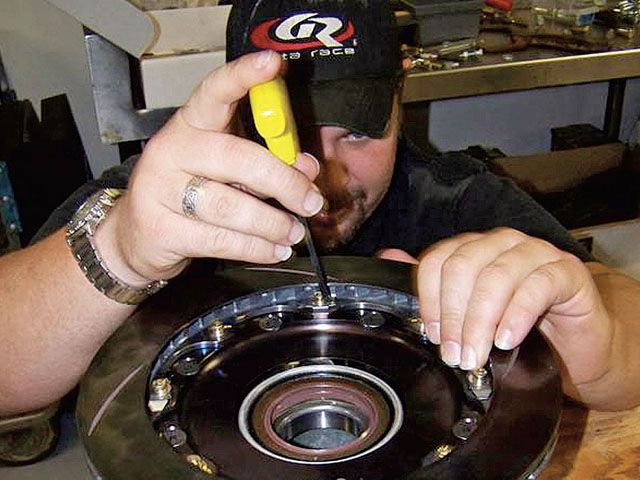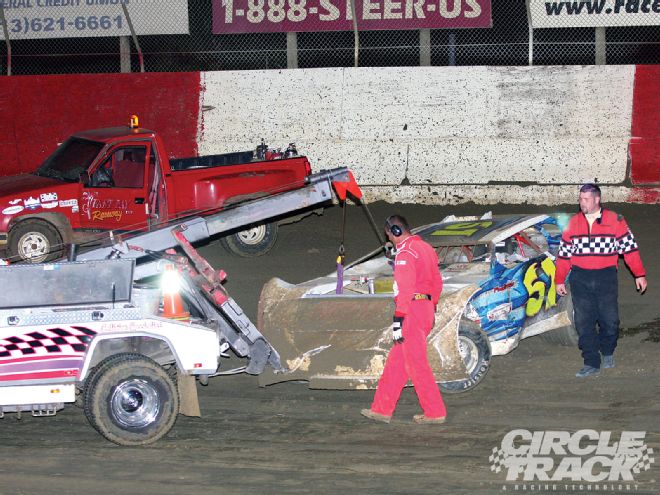
Late last season at East Bay Raceway Park in Tampa, our Roush Yates Engine performed flawlessly in the heat race and landed Project DLM solidly in the feature. Needless to say the whole team was pumped. But seven laps into the feature, the car snapped around on me as I entered Turn 3. A catastrophic brake rotor failure ended what was a promising night. Now, we needed to go in search of new brakes. Enter Brembo of North America.
 This is what can happen when brakes fail. I ended up on the hook after a part failed. It turned out to be the perfect time to upgrade the brake system on Project DLM.
This is what can happen when brakes fail. I ended up on the hook after a part failed. It turned out to be the perfect time to upgrade the brake system on Project DLM.
American racers know Brembo as a top-of-the-line brake manufacturer used by NASCAR's Cup series teams. But did you know that it also has nine overall victories at the 24 Hours of Le Mans in the past 10 years? Yeah, I didn't know that either; and to be honest I really didn't care-although, you have to build a pretty darn good brake system to win that many races (of any type) in a row. Brembo is actually an Italian company that got its start in 1961. It began racing in 1975 when Enzo Ferrari picked the company to help stop his Formula 1 cars. Nice right? But stick with me; all this history is going somewhere.
Brembo engineers have developed dedicated brake systems for many of the upper level racing series in this country. Guys in NASCAR and top-tier road racing use the company's systems, but until recently they haven't been involved in our world, short track racing. That changed a couple of years ago.
"We kept getting questions from grassroots racers. 'What do you make for my car?' they'd say," explains Brembo's John Hayworth. "When your customers ask enough, it opens your eyes."
Since Brembo is an Italian company, the U.S. arm had to do some selling to their European bosses to get the green light. Fortunately for short trackers, they did.
Starting in 2007, Brembo's U.S. engineers started conceptualizing what it would take to put together a kit for a Dirt Late Model. With help from Kevin Rumley at Xceldyne, it was decided to do something a little extreme and outside the box. The goal was to design a brake system that was smaller in diameter and caliper size, but with the same clamping force. Let me tell you, when I opened the box I was a little surprised about just how small these calipers are. I thought there is no way this is going to stop my car. But then I remembered that Brembo designs systems for Formula 1, so I should be OK.
Beyond having a radically small (read lightweight) design, the Brembo team also wanted this to be a bolt-on system that required no major changes on the racer's part. In another departure from the norm, it also recommend smaller 3/4 master cylinders, front and rear, with a 7:1 pedal ratio. The bottom line is that Brembo wanted to make the system so stiff that there wasn't any play anywhere.
With the design prototype and the first systems out in the field, Brembo put some seriously heavy R&D time into the package. "We ran the snot out of this for a year or more," said Jim Kontje, Brembo North America's Motorsports Director. "Our goal was to allow the Dirt Late Model racer the ability to run 70 shows a year, problem-free; that's where the relentless testing came into play. We wanted this thing to be bulletproof."
So testing and racing the package throughout 2008 and 2009, allowed the team to fully validate the fact that the system would last 70 races before releasing it to the general public. Today, guys like Steve Blackburn, Josh Richards, and more are running this system with much success.
We're just getting ours bolted on to Project DLM but I've already seen a number of features that I like. Brembo's Dirt Late Model kits feature a four-piston design in a small, lightweight package. The kit comes complete with Brembo Racing slotted rotors that include lightweight aluminum bells, racing pads, and all the necessary brackets and hardware. That makes installing this brake kit about one of the simplest things to do. There are essentially four components to the kit, calipers, pads, rotors, and brackets.
Calipers Our calipers are machined from racing-specific billet alloy. Brembo says that this will increase stiffness and enhance pedal feel at elevated temperatures, which I can't personally wait to try out. Now, the calipers utilize high-temperature, severe-duty pistons and seals that are specifically designed for our application. The Mono Block Caliper Design features twin bleeders, four aluminum hard-coat pistons (30/36mm), which resist flexing and is one of the lightest designs out there. They are Radial Mount Calipers and must be torqued to 18 ft-lb. Brembo provides shim kits to space calipers 0.040-inch away from hub fingers. That's a nice plus about this kit, it's made for a Dirt Late Model from the inside out.
Pads Brembo's Hawk DTC 30 pads (front and rear) are extra-thick and feature high-torque race compounds designed to deliver high friction levels at a wide range of temperatures; high sensitivity to pressure modulation; and high-temperature, fade-free performance. The pads are actually a combination of special materials such as metallic compounds with blended carbon and graphite particles. The graphite provides a high-temperature lubricant base. Brembo says that the result is a smoother, predictable, and consistent brake engagement along with exceptional release characteristics not found in most racing friction materials. We'll be testing these brakes as part of our shakedown of the new Mastersbilt car in an upcoming issue, so keep your eyes peeled for that one.
Rotors The pre-assembled floating rotor/hat features curved vanes that aid in cooling. The rotors are factory balanced, and at 0.700-inch wide and 10.9 inches in diameter, they are slightly smaller than our cross-drilled set we had on the car last year.
Bottom Line Installing this system was a piece of cake. Brembo's kit is completely turnkey and everything bolted right up and fit perfectly. We'll use No. 3 brake line when it comes time to hook everything up. But the real exciting part of this install was the weight savings. Brembo says that racers should expect a 26- to 36-pound weight reduction over conventional Dirt Late Model brakes. Our 29-pound weight savings falls right in line with those claims.
Everything we've seen from this system points to a first-class package you'd expect from a company with the reputation of Brembo. We've heard that pedal feel consistency is predictable from the beginning of the race to the end, and you can therefore run conservative in the early going, saving the car until "go-time" at the end of the race. We'll have a full report on the performance on our new system in a future issue of Circle Track after we've had a chance to test and race this system. In the meantime, if you'd like to get a set of your own, it is available exclusively through CV Products for a price of $2,497.50. While you might say that's a bit pricey, it'll likely be the last brake system you ever buy, unless you stuff it in the wall and break something.